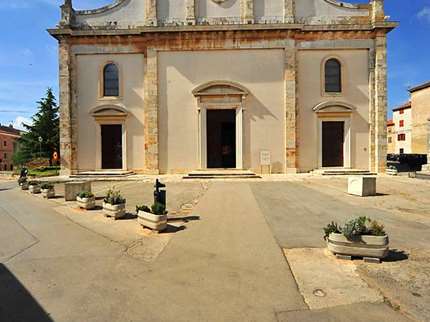Parish Church of St. Blaise
One of the most impressive structures in Vodnjan and entire Istria is certainly the parish church of St. Blaise, well-known to pilgrims from all over the world. Apart from the relics of St. Blaise, Vodnjan's parish church also keeps 370 relics belonging to 250 different saints. In addition to one of the thorns from Jesus' crown, fragment of the Holy Virgin's veil, particle of Jesus' Cross and many others, a special attraction are the desiccated remains of saints whose bodies or body parts have been completely preserved: St. Sebastian, St. Barbara, St. Mary of Egypt, St. Leon Bembo, St. Giovanni Olini and St. Nicolosa Bursa.
Address:
Svetoga Roka 4, 52215 Vodnjan
Find on the map(0)52 511420 marijan.jelenic@pu.t-com.hr www.zupavodnjan.com
One of the most impressive structures in Vodnjan and entire Istria is certainly the parish church of St. Blaise, well-known to pilgrims from all over the world. On the site of the present-day parish church once stood a basilica, most probably from the 11th century, that was pulled down in 1760. The new church was modelled after the Venetian church of San Pietro, and the project itself cost 13,000 gold coins. The church was financed by the townspeople and its construction lasted from 1760 to 1800. At that time the locals set aside 10% for the building of the church, whereas over the next ten years they set aside 10% of wine and olive oil. Today this church is the largest and one of the most magnificent ones in Istria.
Apart from the relics of St. Blaise, Vodnjan's parish church also keeps 370 relics belonging to 250 different saints. In addition to one of the thorns from Jesus' crown, fragment of the Holy Virgin's veil, particle of Jesus' Cross and many others, a special attraction are the desiccated remains of saints whose bodies or body parts have been completely preserved: St. Sebastian, St. Barbara, St. Mary of Egypt, St. Leon Bembo, St. Giovanni Olini and St. Nicolosa Bursa. These remains in St. Blaise's Church have been there for centuries, without being embalmed or hermetically sealed which presents a true mystery for scientists. However, this is not the only mystery. According to legend the preserved bodies of saints are considered to have magical powers.
In 1818 the saintly relics were brought to Vodnjan from Venice, since everything sacral was destroyed because of the French Revolution. The great painter and member of the Royal imperial academy of fine arts, Gaetano Grezler from Venice took charge of the relics and stored them. In search of an artist that would decorate the newly-built parish church, Vodnjan's Church Fathers chose Gretzler. He arrived by sailing ship, bringing with him the relics.
The Collection of Sacral Art in the parish church of St. Blaise is the most magnificent one in Croatia. There are over 730 exhibits dating from the period between the year 400 and the 19th century. The collection comprises stone reliefs, fifteen paintings on canvas and wood, fifteen sculptures, some hundred precious reliquaries, numerous books and manuscripts, jewellery, vestments, etc, presenting a complete picture of the Middle Ages. Although St. Blaise's Church hasn't been officially proclaimed a place of pilgrimage 15,000 worshippers visit the church every year.








